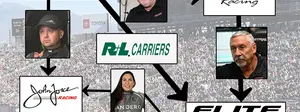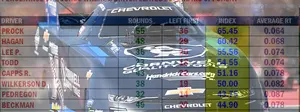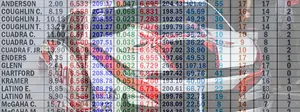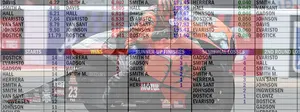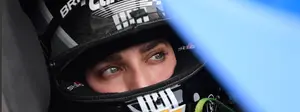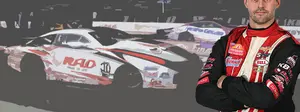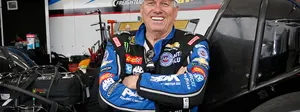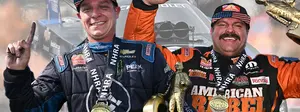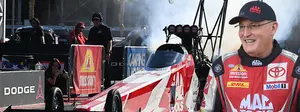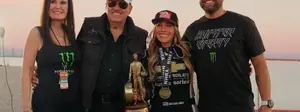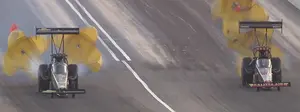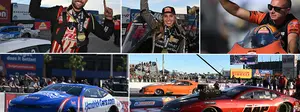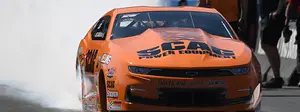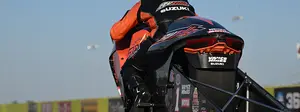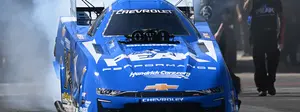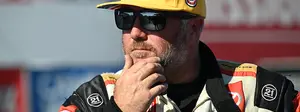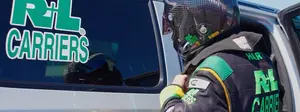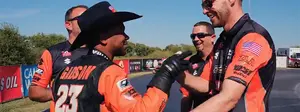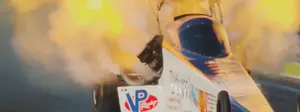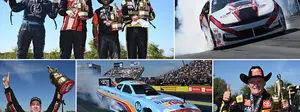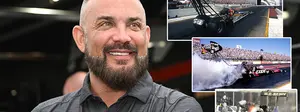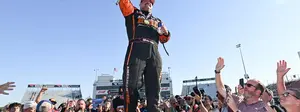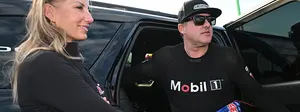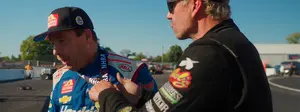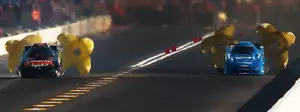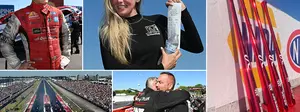

Matt Hartford relishes the never-ending pursuit of perfection in NHRA drag racing

Driving a Pro Stock car is an abject lesson in the fine art of frustration. It’s a task that simply can’t be mastered. From burnout, staging, shifting, car control, and at least a dozen other disciplines that most fans never see, success requires 99.9% efficiency. Over-rev the engine, miss a single shift by 50 rpm, or drive out of the groove by nary the width of a tire, and there’s a steep price to pay, and it will be reflected on the time slip. Individually, each miscue might not appear significant, but in a class where races are decided by thousandths of a second, perfection means everything.
When he won the 2017 NHRA Mello Yello Drag Racing Series championship, Bo Butner said driving a Pro Stock car was the hardest thing he has ever done. Matt Hartford agrees.
“Bo is absolutely right; if you’ve never tried it, you just don’t understand how difficult it can be,” said Hartford, as he currently pursues Butner for the 2019 title. “All the time, I tell people if they want to try Pro Stock, come on in. The water is nice. I’m never critical of anyone who drives a race car, and that includes the nitro guys, but until you sit in the captain’s chair, you have no idea.
“In Pro Stock, just doing a burnout is hard,” said Hartford. “Too much [rpm] and you might drop a valve. Not enough and you’ll stick the tire and burn up the clutch. When you set up the car, you do it every time anticipating a perfect burnout and a perfect launch, so if you don’t nail it, it’s going to cost you. I’ve made 1,000 mistakes driving a Pro Stock car, but that’s a drop in the bucket compared to how many are possible. It’s hard to grasp this, but I’m never going to be perfect. You can’t make a perfect run. It doesn’t exist, but you can be close. In fact, you have to be almost perfect because these are such technical cars to drive.”
Let that one sink in for a second. As a Pro Stock racer, you spend your entire career chasing perfection, but do so with the understanding that it’s never going to happen. Hartford understands what he’s up against, and he not only accepts it willingly, but he actually thrives on the challenge.
“I think everyone out here has the same mentality,” he said. “Some runs will not go as planned, so you fix it and move on. You just have to be able to learn from mistakes, so you don’t make them again.”
***

Hartford has a knack for being in the right place at the right time, and exhibit A is his 2019 season. When NHRA announced the shortened 18-race schedule for Pro Stock, Hartford’s stars aligned like triple sevens on a slot machine, and for the first time, he’s able to compete for the Mello Yello championship. Hartford had already put together the pieces for a title run, including a top-notch team that includes his supportive wife, Amber, as well as vastly underrated crew chief Eddie Guaranaccia and crewmembers Kris Ingaldson, Adam Bastion, and David Trujillo. With a competitive engine-leasing agreement with Elite Performance, the only thing missing for Hartford was a schedule compatible with his budget, and his work obligations at Total Seal piston rings, the company where he’s worked for 21 years, and of which, he’s now part owner. Last year, Hartford proved he could win when he barreled through the field in Houston, and now, he has the opportunity to follow Butner’s lead and chase a championship.
“I never had the chance to race like this or to win a championship,” said Hartford. “I used to run about 15 races on average. Last year, had I not skipped a few races, I might have gotten in [to the Countdown to the Championship], but we don’t know. That was a little frustrating. This time, I won’t have to wonder what might have happened.”
After seven races this season, and 100 in his career, Hartford currently sits in fifth in the standings. No one is going to catch runaway leader Butner for the top seed, but Hartford is just seven points out of third place. Once the six-race Countdown playoff starts, it’s a free-for-all where any driver in the top 10 has a realistic shot at the championship, so yes, Hartford is exactly where he wants to be.
“We have a very strong team, and that’s humbling to me,” he said. “When I look at Pro Stock as a whole, there have only been 67 unique winners in the history of the class. To be one of 67 out of probably 1,500 that have competed in the class is overwhelming. I don’t think time on the pond guarantees success. This is like any competitive sport: You have to assemble a strong team to be successful. One individual can’t do it all. In 1983, you could maybe do it with one or two people, but not in 2019. You need a well-oiled machine just to have a chance to qualify. I owe it all to the people who support me.”

Hartford’s season so far has been a mixed bag. In qualifying, he has been a rock star with only one start outside the top eight. He also has a pair of runner-up finishes, including his home event in Phoenix, where he lost the final to Jeg Coughlin on a red-light. Asked to rate his performance, Hartford is brutally honest. He gives his team a solid A but rates his own performance as closer to a B minus. Some racers have a hard time looking in the mirror and acknowledging their own shortcomings, but Hartford isn’t one of them.
“The only reason we didn’t win Phoenix was the driver,” he said, completely overlooking the two holeshot wins that got him to the final. “Our car was competitive, but I went red and then shook the tires. Had we been clean and green, Jeg left the door open. I think about what a phenomenal party we’d have had that night. As a driver, I feel like I let the team down, but the great thing about Eddie is that there is never any negativity. That’s why we’ve been successful. He feels the same way I do. We might disagree on things from time to time, but we can sit in the trailer and talk about it. Eddie says all the time that it only takes one run to fix your attitude, and he’s absolutely right.”
***
Hartford does have a knack for being in the right place at the right time, but not always. On Aug. 1, 1990, at age 18, he enlisted in the U.S. Navy. The next day, Operation Desert Storm began, and the country was suddenly at war in the Middle East.
“I was in the Navy for 12 hours before the conflict started, and I’m not sure that made my mom very happy,” he joked. Hartford joined the Navy’s nuclear engineering program, where he learned the finer points of the fission reactors that power the Navy’s fleet of submarines. “I figured that if I was going to be in the military during a war, it might as well be on a boat that was designed to sink. Seriously, if I’d been asked to go [into combat], I would have done it, but I spent most of my time in Maine and New Hampshire. I joined the Navy because they have the best nuclear engineering program in the world. It’s extremely technical, and maybe that’s why my hair is still yellow today.”
Six-time champ Warren Johnson is known as the professor of Pro Stock, but even WJ doesn’t have a background in nuclear engineering, which begs the question, does Hartford’s Navy training help make him a better racer?
“Not really, except you learn that education is the key,” said Hartford. “You just can’t take someone with no education and put them around a nuclear reactor. It will go south in a hurry. I guess that also applies to racing. You can’t take someone racing a 14-second street car and hand them the keys to a Pro Stock car. There is a night-and-day difference. The military also teaches you to adapt to any situation and to work as a team.”

In his racing career, Hartford has put those lessons to good use. He came to Pro Stock from Comp eliminator, but before that, he was one of the biggest stars in the NHRA Sport Compact series, driving some of the most exotic machinery available at the time.
“In the 1990s, I ran a dragster with a blown alcohol engine that was sort of a Top Dragster before that was even a class,” said Hartford. “Then in 1999, I got a call from Ford to drive a Focus in the Sport Compact series. At the time, I’d never even heard of it, but it had a twin turbo V-6 and a G-Force [transmission] and a Pro Stock chassis. I drove that for a year and then got a call from John Lingenfelter to drive for General Motors and Summit. I idolized John and loved his A/Dragster and his Corvettes, so how could I say no? I won the championship, and I learned a lot about racing and engine development. We had to run factory parts, so we blew up a lot of them. Then, John had his accident and passed away.”
It’s reasonable to think a kid with a background in nuclear engineering, and who’d enjoyed success with turbocharged sport compact cars, would want nothing to do with the comparatively antiquated world of Pro Stock, with (then) carbureted gas-burning engines, but Hartford never saw it that way.
“I loved Pro Stock since the early 1980s,” he said. “There has always been something about carburetors and tunnel rams and hood scoops that’s appealed to me, and I still wanted to give that a shot. I was going to do an IHRA Pro Stock program with a turbocharged V-Í6, and I even had a new Don Ness car on the way, then Steve Schmidt called and wanted to buy the car. I told him it was for sale, but I wanted to do six races with him. I wanted to show up and have him teach me all that he could. He agreed, and that’s how I got into Pro Stock.”
***

Pro Stock isn’t a cheap way to drag race, and it never has been. The mere mortals who believe they could have run with Bill Jenkins and Ronnie Sox in the 1970s if given the chance are sadly mistaken. It takes lots of money and lots of talent, and it always has. At the risk of belaboring the point, Hartford goes to great lengths to credit not only his crew but also a cast of supporters that includes Kenny Koretsky, Larry Webb of The Hose Connection, CIP1, Rob’s Automotive and Collision, Curry’s Transportation Services, Quality Flooring, and his team at Total Seal.
“It’s all about the people around me,” he claimed. “Kenny Koretsky has been with me since the mid-2000s, and he’s been friends with Eddie for a lot longer. Last year, after NHRA announced their schedule, I went to dinner with Larry Webb, and after a couple of bottles of wine, I asked him if he was interested in taking a shot at the championship. I only wanted to do it if I felt we had a real shot. He said, ‘I wouldn’t have it any other way.’ The rest of my sponsors were the same. They understand. They are the reason why I race. They believe in me, and that’s very humbling.”

Whenever Hartford needs an extra shot of motivation, he needs only to think back to his victory in Houston last year. The No. 11 qualifier going into race day, his odds were not great, but after wins against Chris McGaha and world champions (or soon-to-be world champions) Tanner Gray, Jeg Coughlin Jr., and Erica Enders, he was crowned the 66th different Pro Stock winner since 1970.
“I not only didn’t do everything right, we did a lot wrong,” Hartford recalled. “We were by no means a well-oiled team. Our truck broke down, and then against Jeg, we went to the starting line with three pounds of air in the rear tires. The pair in front of us was doing their burnout, and my guys were grabbing every air tank they could find. I told them I didn’t care how much air was in them, as long as they were even. I let the clutch out, and it quivered all the way through low gear, but Jeg shook and shut off. For the final, we threw the sink at it and ran low for the event. Erica had me, and I drove around her. I couldn’t believe it. My crew was in tears. That was monumental for my guys. I’ll never forget that day.”
***
Hartford’s desire to succeed in Pro Stock is reflected in his attitude toward business. He became the president and CEO of Total Seal on June 7, after he joined an investment group, Promus Equity Partners and Jon S. Vesely, to purchase the company. Hartford’s already hectic life has gotten even more frenzied, but you won’t hear him complain.
“My job has changed, and it’s been an enlightening experience for sure, but I put myself in this spot,” Hartford said. “Work still comes first, and it is my priority. Thankfully, we do use the race car for ring development and as a marketing platform for Total Seal. I’m very fortunate to have people who can handle day to day business.”
He goes to great lengths to keep his priorities in order, and in addition to business and racing, Hartford makes time to pursue his other passion: cooking.
“When we’re home, I probably cook six nights a week,” he said. “I love it. It’s a creative outlet, and it’s all trial and error. Amber will say, ‘Can you make those braised short ribs again?’ Yes, I can make them, but they won’t be exactly the same as last time because I don’t measure anything. I do it by taste. I guess it’s similar to building a Pro Stock team, you take raw ingredients and turn them into something that people enjoy — something successful. To me, it’s all about accomplishing goals.”























